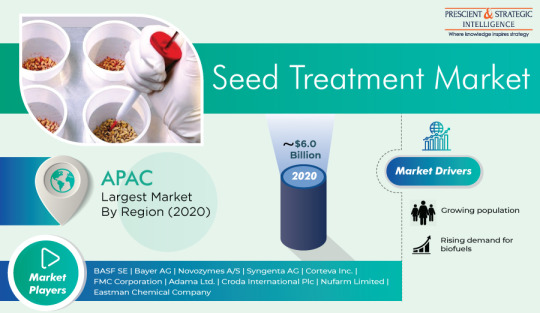#Bio-based Solutions
Explore tagged Tumblr posts
Text
Seed Treatment Market: Enhancing Crop Yield and Protection
If it is said that the entire agriculture is dependent on seeds, then surely it is right. They are the point of initiation of a crop lifecycle, and if the seeds don’t germinate, crops fail. There are a lot of challenges faced by seeds, such as pests to diseases and also environmental conditions. It is a fact that seeds can come on top of all these challenges by themselves, the probabilities for…

View On WordPress
#agriculture#Bio-based Solutions#Crop Productivity#Crop Protection#crop yield#Disease Management#Global Food Security#innovations#market trends#Modern Agriculture#pest control#Seed Treatment Market#Seed Treatments#Sustainable Farming
0 notes
Text








@reptile--queen thank you that you don't mind I post them here <3
#don't mind me guys.#I just need to create a link for some OCs based on meerkats because they are important#otherwise their bio is totally not aesthetic without their pics.#OCs#only because discord is so stubborn and 'vanished' them after a time#I need those babies for the rp with my twin qwq discord you are so unfair.#meerkats#fantasy meerkats#I also would reblog if there will be new OCs when I made pics of them <3#thanks my twin and I hope that does not really bother you. It was the best solution I could do.#I really grow fond of meerkats ajlfkö#tumblr please. Be better and be working qwq
6 notes
·
View notes
Text
Shop Home Cleaning Essentials – Non-Toxic & Powerful Cleaners
Upgrade your cleaning routine with Nature's Pick Market's premium range of household cleaning products. From multi-surface disinfectants to biodegradable detergents, we ensure a spotless, fresh-smelling home with eco-friendly care. Say goodbye to germs and dirt—order now!

#Household Cleaning Products#Eco Friendly Cleaning#Natural Cleaning Solutions#Bio degradable Detergents#Nature Based Cleaning#Chemical Free Cleaners#Nature's Pick Market#USA
1 note
·
View note
Text
Future of Biorefinery Market: Renewable Energy & Circular Economy Insights
The global biorefinery market is at the forefront of a revolution aimed at replacing fossil-based products with renewable alternatives. As the world grapples with the effects of climate change and a growing need for sustainable solutions, biorefineries have emerged as critical players in the transition towards a circular economy. By transforming organic materials into biofuels, biochemicals, and biomaterials, biorefineries offer a pathway to reduce reliance on fossil fuels and mitigate environmental impact.
Request Sample Report PDF (including TOC, Graphs & Tables): https://www.statsandresearch.com/request-sample/40629-global-biorefinery-market
Overview of the Biorefinery Market
The biorefinery market is evolving rapidly, driven by the global shift towards cleaner, more sustainable energy production and chemical manufacturing. In 2024, the global biorefinery market was valued at approximately USD 223.16 billion. Projections suggest a robust compound annual growth rate (CAGR) of 8.4% from 2025 to 2032. This expansion is largely fueled by heightened consumer awareness of environmental issues, stringent government regulations, and technological advancements in bioprocessing.
Biorefineries leverage renewable feedstocks to produce bio-based products. These include biofuels like biodiesel and bioethanol, bio-based chemicals such as organic acids and solvents, and biomaterials like bioplastics. The increasing emphasis on a circular economy, coupled with global efforts to decarbonize industries, has significantly impacted the demand for biorefinery products.
Get up to 30% Discount: https://www.statsandresearch.com/check-discount/40629-global-biorefinery-market
Biorefinery Market Drivers and Key Trends
1. Rising Demand for Renewable Energy
The transition to renewable energy sources is one of the primary drivers of the biorefinery market. As fossil fuels continue to contribute to environmental degradation, renewable biofuels have gained prominence as sustainable alternatives. Bioethanol and biodiesel, derived from agricultural feedstocks like corn and sugarcane, have found widespread use in transportation, particularly in countries like the U.S. and Brazil.
Sustainable aviation fuel (SAF) is another rapidly growing segment, as airlines aim to reduce their carbon emissions and comply with international sustainability goals. With the aviation industry contributing significantly to global emissions, SAF offers a viable solution to curbing its environmental impact.
2. Government Policies and Incentives
Governments around the world have introduced policies and incentives to foster the growth of the biorefinery sector. These include tax breaks, subsidies, and grants designed to encourage research and development in bio-based technologies. For instance, the European Union has established ambitious renewable energy targets, prompting increased investments in biofuel production and biorefinery infrastructure.
3. Technological Advancements in Bioprocessing
Technological progress in bioprocessing is a key enabler of market growth. Innovations in enzyme technology, microbial fermentation, and metabolic engineering have significantly enhanced the efficiency of biorefining processes. For example, advancements in lignocellulosic conversion allow for the effective utilization of non-food feedstocks like agricultural waste, reducing competition with food production.
In addition, thermochemical and biochemical conversion processes are being optimized to increase yields, improve scalability, and reduce the environmental footprint of biorefinery operations. This includes the use of anaerobic digestion, gasification, and pyrolysis to convert biomass into valuable products.
4. Increasing Focus on Sustainability
As environmental concerns continue to rise, businesses and consumers alike are demanding more sustainable alternatives to conventional products. The biorefinery market is benefiting from this shift, with growing consumer preference for bio-based chemicals and materials. Industries such as packaging, textiles, and automotive are adopting bioplastics and bio-composites to reduce their environmental impact.
The increased use of agricultural residues, organic waste, and algae as feedstocks also aligns with sustainability goals. These feedstocks help minimize waste and reduce the need for land dedicated to energy crop production.
Biorefinery Market Segmentation Analysis
The biorefinery market can be segmented by type, product, raw material, technology, end-user, and region.
1. By Type of Biorefineries
The biorefinery market is divided into three main categories based on the type of feedstock used:
First-Generation Biorefineries: These biorefineries primarily use food-based feedstocks such as sugarcane, corn, and wheat. They are the most established and dominate the market due to their lower production costs.
Second-Generation Biorefineries: These utilize non-food biomass, such as agricultural waste and forestry residues. They are growing rapidly, particularly due to the global push for sustainability.
Third-Generation Biorefineries: These employ advanced feedstocks like algae and other high-yield biomass. These biorefineries hold significant potential, particularly in terms of their high productivity and low environmental impact.
2. By Product
The main products produced by biorefineries include:
Biofuels: Bioethanol, biodiesel, and sustainable aviation fuels dominate the market, driven by the rising demand for renewable energy in transportation and aviation sectors.
Biochemicals: The demand for bio-based chemicals, such as bio-based solvents, organic acids, and biopolymers, is growing, with applications spanning across industrial and consumer goods.
Biomaterials: Bioplastics and bio-composites are gaining traction in industries like packaging and automotive, driven by the increasing demand for sustainable alternatives to petroleum-based products.
3. By Raw Material
Raw materials used in biorefineries include:
Agricultural Residue: Crop stubble, straw, and husks are widely used due to their cost-effectiveness and availability.
Energy Crops: Crops like switchgrass and miscanthus are being increasingly used for their high biomass yield and environmental benefits.
Organic Waste: Food waste, manure, and municipal solid waste are increasingly being utilized for biogas production and biofertilizers.
4. By Technology
Biorefineries employ various technologies for conversion processes:
Biochemical Conversion: The largest market segment, driven by innovations in enzymatic hydrolysis and microbial fermentation technologies.
Chemical Conversion: Used primarily for bio-based solvents, organic acids, and specialty chemicals.
Thermochemical Conversion: Gaining momentum in biofuel production, with processes such as gasification and pyrolysis.
5. By End-User
The biorefinery market serves various end-user industries:
Transportation: The largest segment, due to the increasing adoption of biofuels such as biodiesel and ethanol in vehicles.
Agriculture: Bio-based fertilizers and pesticides are gaining popularity for their reduced environmental impact.
Pharmaceuticals: Biochemicals derived from renewable sources are used in drug production and healthcare applications.
6. By Region
Regionally, the global biorefinery market is segmented into:
North America: The U.S. is a key player, with significant investments in biofuels and biorefinery technologies.
Europe: Dominates the market due to stringent environmental regulations and substantial investments in sustainable energy.
Asia-Pacific: Emerging as a high-growth region, driven by increasing demand for renewable energy and bio-based products.
Key Biorefinery Market Players and Competitive Landscape
The global biorefinery market is highly competitive, with several leading companies investing heavily in technological advancements and strategic partnerships to expand their market share. Notable players in the market include:
Chevron: Investing in bio-based chemicals and biofuels production to diversify its energy portfolio.
Neste: A leader in renewable diesel and SAF production, driving sustainability in the transportation sector.
ADM: Focusing on the development of second-generation biofuels and biochemicals.
Valero: Expanding its renewable fuels business to meet the growing demand for sustainable energy.
Recent Developments in the Biorefinery Market
Several significant developments have occurred in the biorefinery sector recently:
Honeywell and SGP Bioenergy Collaboration: In October 2024, Honeywell partnered with SGP Bioenergy to develop scalable technology that converts industrial hemp into biochemicals, including biodegradable plastics.
Raizen and Vertoro Partnership: In August 2024, Raizen joined forces with Vertoro to explore lignin applications, focusing on producing advanced biofuels and chemicals.
Neste’s Co-Processing Innovation: In February 2024, Neste introduced its renewable feedstock solution for the polymer industry, advancing the transition to circular and sustainable solutions.
Purchase Exclusive Report: https://www.statsandresearch.com/enquire-before/40629-global-biorefinery-market
Conclusion: The Future of the Biorefinery Market
The global biorefinery market is poised for significant growth, underpinned by the increasing demand for renewable energy, sustainable chemicals, and bio-based products. Technological innovations in bioprocessing, advancements in feedstock utilization, and favorable government policies are driving the market forward. As industries seek to reduce their environmental impact and transition to cleaner, more sustainable production methods, biorefineries will play an essential role in shaping the future of energy, chemicals, and materials.
Our Services:
On-Demand Reports: https://www.statsandresearch.com/on-demand-reports
Subscription Plans: https://www.statsandresearch.com/subscription-plans
Consulting Services: https://www.statsandresearch.com/consulting-services
ESG Solutions: https://www.statsandresearch.com/esg-solutions
Contact Us:
Stats and Research
Email: [email protected]
Phone: +91 8530698844
Website: https://www.statsandresearch.com
#Biorefinery Market#Biorefinery Growth#Sustainable Energy#Renewable Chemicals#Bio-based Materials#Circular Economy#Enzymatic Hydrolysis#Fermentation Technologies#Bioprocessing#Carbon Emissions Reduction#Renewable Energy Market#Market Forecast 2024#Biorefinery Technologies#Biorefinery Opportunities#Green Energy Solutions#Environmental Regulations#Biofuels#Market CAGR#Biorefinery Innovation#Sustainable Market Growth#Biorefinery 2032.
1 note
·
View note
Text
The Global Pressure Sensitive Adhesives Market: Growth Drivers, Key Trends, and Future Opportunities

The Pressure Sensitive Adhesives Market is undergoing a significant transformation, driven by technological advancements, sustainability demands, and a surge in applications across diverse industries. Pressure sensitive adhesives (PSAs) are versatile bonding solutions activated by light pressure, widely used in tapes, labels, graphics, and medical applications. As industries seek faster, cleaner, and more flexible assembly processes, PSAs are capturing attention from manufacturers, engineers, and product developers globally.
Key Growth Drivers
A primary driver of the Pressure Sensitive Adhesives Market is the shift towards lightweight, high-performance materials in automotive, electronics, and packaging. Automotive adhesives and tapes are increasingly replacing mechanical fasteners, contributing to vehicle weight reduction and improved fuel efficiency. Likewise, medical adhesives are enabling non-invasive, skin-friendly wound dressings and wearable sensors — critical in advancing digital healthcare.
The packaging industry’s rapid growth, particularly in e-commerce, has also escalated demand for packaging adhesives, enabling quick, secure, and tamper-evident seals for boxes, pouches, and flexible packaging. Moreover, the expanding consumer electronics sector, including flexible displays, relies on PSAs for bonding delicate layers without compromising clarity or flexibility.
Evolving Adhesive Technologies
The market is witnessing innovation in adhesive technology trends, with manufacturers focusing on sustainable and high-performance solutions. Water-based adhesives and hot melt adhesives are gaining popularity due to their low VOC emissions and faster processing times. Among chemistries, acrylic adhesives dominate, offering excellent UV resistance, transparency, and adhesion across varied substrates.
A notable trend is the development of smart adhesives, which incorporate functionalities like conductivity, reusability, or sensing capabilities, catering to next-generation electronics and IoT devices. Additionally, bio-based PSAs derived from renewable resources are emerging as viable alternatives to petrochemical-based adhesives, aligning with circular economy goals.
Sustainability and Regulatory Influence
Heightened regulatory scrutiny and consumer awareness are accelerating the shift towards sustainable adhesives. Regulations limiting solvent emissions have propelled research into greener formulations, especially water-based and bio-based products. Major brands in labeling and packaging sectors are adopting eco-friendly labeling solutions to reduce environmental impact and enhance recyclability.
The tapes market segment, a major consumer of PSAs, is evolving with demand for specialty tapes that offer heat resistance, electrical insulation, or anti-counterfeit properties. Sustainable tapes and labels are becoming standard in food packaging and retail, driven by both corporate responsibility and end-user expectations.
Future Opportunities
The Pressure Sensitive Adhesives Market is poised for robust growth, with opportunities in emerging applications like wearable medical devices, electric vehicles (EVs), and advanced flexible electronics. For instance, in EVs, PSAs enable thermal management, vibration damping, and lightweight assembly. In flexible displays and foldable smartphones, PSAs offer optical clarity and mechanical durability.
Investors and procurement managers should watch regions like Asia Pacific, where rising industrialization and consumer demand are creating significant PSA market potential. Meanwhile, continuous R&D into hybrid and nanostructured PSAs promises to unlock applications previously unattainable with traditional adhesives.
Download the PDF Brochure to explore detailed market insights, forecasts, and growth strategies tailored for your industry segment.
The Pressure Sensitive Adhesives Market is no longer just about simple tapes or labels. From medical adhesives enabling next-gen healthcare devices to automotive adhesives revolutionizing vehicle assembly, PSAs are at the heart of innovation across industries. As sustainability becomes non-negotiable, sustainable adhesives and bio-based PSAs will define future success in this market.
For manufacturers, engineers, and investors, staying ahead of these adhesive technology trends and evolving PSA applications will be key to leveraging the immense potential of this dynamic market.
#Pressure Sensitive Adhesives Market#PSA applications#Water-based adhesives#Hot melt adhesives#Acrylic adhesives#Medical adhesives#Automotive adhesives#Packaging adhesives#Sustainable adhesives#Adhesive technology trends#Smart adhesives#Bio-based PSAs#Flexible displays#Labeling solutions#Tapes market
0 notes
Text
#Herbal Mouthwash#Ayurvedic Mouth Rinse#Natural Oral Care#Gum Strengthening Mouthwash#Alcohol-Free Herbal Mouthwash#Clove Neem Tulsi Mouthwash#Ayurvedic Solution for Bad Breath#Mouthwash for Sore Throat Relief#Ayurvedic Cavity Protection#Bio Resurge Oral Care#Plant-Based Mouthwash#Made in India Herbal Mouthwash
0 notes
Text
From Research to Reality: How 5 African Women Scientists Are Solving Food Security Challenges
Across Africa, an inspiring story is unfolding. Women scientists who have personally witnessed their communities struggle with scarce resources – from water shortages to lack of nutritious food – are stepping forward with solutions. Having experienced these challenges first-hand, they’re combining their scientific expertise with deep local understanding to tackle problems they’ve seen affect…
#aflatoxin contamination#African crop yields#African farming innovations#African food processing techniques#African food security solutions#African food systems#African traditional crops#African women entrepreneurs#African women in climate action#African women in community resilience.#African women in crop health#African women in education#African women in food systems#African women in innovation#African women in livestock management#African women in nutrition#African women in science#African women in sustainability#African women in technology#African women mentors#African women researchers#African women scientists#Agnes Otwani#Asero Diana#bio-based solutions Africa#cassava nutrition#climate change and agriculture#climate-resilient farming#Dorah Momanyi#Eden Lencha
0 notes
Text
Plant Fertilizer
Boost your crops’ health and yield with BG-BIO 520, a premium liquid plant fertilizer designed for modern agriculture. Formulated with advanced nutrients, it promotes strong root development, faster growth, and higher productivity.
#Plant Growth Promoter#Liquid Fertilizer#Bio 520 Beyond Green#Organic Growth Enhancer#Sustainable Agriculture#Crop Yield Booster#Natural Plant Nutrition#Soil Enrichment#Plant Health Improvement#Eco-friendly Farming#Agricultural Solutions#Fertilizer for Plants#Bio-based Growth Enhancer#Sustainable Crop Production
0 notes
Text
"A German bio-tech company has developed a naturally-occurring enzyme discovered in a cemetery into a near-market ready solution for recycling plastic without any loss of quality.
In 2022, GNN reported on a paper published by Leipzig-based scientists who first identified the enzyme. At the time, the enzyme was subject to a small side-by-side test, and caused the polyethylene terephthalate (PET) plastic to decompose by a whopping 90%.

Pictured: Before and After: A container of PET after 24 hours of contact with the enzyme leaves only dye
Fast forward to the spring of 2025 and those same scientists have perfected the capabilities of that enzyme, called PHL7, and have founded ESTER Biotech to bring those capabilities to market.
Their initial plan to be finished next year is a bathtub-sized pilot project reactor. If successful, their 2030 plan will be four 350 cubic-meter reactors capable of processing 45,000 metric tons of PET plastic every year.
PHL7 and ESTER Biotech boast several advantages over chemical and thermal recycling methods. For starters, once the polymers of PET are broken by the enzyme into monomers, or single component parts, they have suffered no degradation of their material characteristics unlike some recycled plastic which is weaker or less stable.
Additionally, PHL7 is exceptionally stable from 32 to 203 degrees Fahrenheit (0-95°C), and per kilogram of plastic, a dose of only 0.02% to 0.06% of the enzyme is required—substantially less than existing alternatives. Their new version of the enzyme also recycles the plastic several hours faster.
“Our technology makes it possible to bring material flows that are currently burned back to the beginning of the cycle at the molecular level,” says Christian Sonnendecker, lead author on the paper of the enzyme’s discovery, and co-founder of ESTER Biotech at the University of Leipzig. “And with high energy efficiency and scalability.”
“We are only at the beginning. But we are convinced that when science, entrepreneurial spirit and social responsibility come together, a cemetery enzyme can become a beacon of hope for a better future.”
RECYCLING BREAKTHROUGHS:
Scientists in Japan Develop Non-Toxic Plastic That Dissolves in Seawater Within Hours
Cornell Researchers Create First-of-its-Kind Durable and Recyclable Plastic
New Process ‘Vaporizes’ Plastic Bags and Bottles to Help Make Recycled Materials
Revolutionary New ‘Living Plastic’ That Could Slash Damage to the Environment Developed by California Researchers
ESTER Biotech’s enzyme is able to separate certain multilayer composites which are normally thought of as unrecyclable. In addition to the infrastructure of the pilot project, ESTER is currently working with two medium-sized partners to build a cost-efficient supply chain with an aim to reduce the enzyme price to between 100 and 200 euros per kilogram.
Though no currently-commercialized recycling method can compete with the cost of virgin plastic, a price between 100 and 200 euros will put it in line with existing competitors.
Fortunately for anyone in the space, the EU is not afraid to use heavy-handed regulation to guarantee plastic recycling rates. By 2040, under existing EU legislation, 65% of plastic production will be mandated to come from recycled sources. ESTER believes that with its potential to offer a higher quality “recyclate,” the incentive to pursue and expand enzymatic methods will increase."
-via Good News Network, June 13, 2025
#recycling#plastic#plastic pollution#environmental science#enzyme#waste#waste management#plastic recycling#germany#eu#europe#good news#hope
3K notes
·
View notes
Text
Green & Bio-Solvents Market: Sustainable Solutions for a Cleaner Future
The total size of the green & bio-solvents market was USD 3,128.5 million in the past, and it will propel at 6.1% CAGR in the years to come, to reach USD 5,322.2 million by 2030, as per P&S Intelligence. The industry development is credited to the and environmental and health concerns related to synthetic solvents. Paints & coatings dominated the industry in the past, with around USD 1.2…

View On WordPress
#Bio-based solvents#Biodegradable solutions#Chemical sector#Clean manufacturing#Eco-conscious industries#Eco-friendly alternatives#Environmental innovation#Green chemistry#Green solvents#Green technology#Industrial applications#Low carbon footprint#market growth#Regulatory compliance#Renewable resources#Solvent industry#Solvent market trends#Sustainable chemistry#Sustainable sourcing
1 note
·
View note
Text
HI i come baring an au i’ve been stupid ab and lowkey forgot i had tumblr and can share it here
A very basic summary so sorry for the plot holes and shitty wrriting





> CRYOGENIC AU
> Thousands upon thousands of years into the cybertronian war, Decepticon Mad Scientist, Shockwave, revealed his new experiment to dictator, Megatron, in hopes it would wipe out the Autobot faction for good. An infectious Bio-weapon dubbed the “Hate Plague” was unleashed onto the unknowing war soldiers.
.
> A violent virus spread through a prolonged touch, of which the infected would succumb to severe amounts of agitation, a loss of control and morality, as well as exhibiting violent behaviours towards any other life forms.
.
> Quickly they exhibited aggression towards each other, hoping the Autobots would tear their own faction apart. However the plague backfired, quickly advancing through cybertronian kind, both factions finding themselves trapped.
.
> Autobot inventor, Wheeljack, quickly explained the situation to the autobot commanders, having found a momentary solution to the virus during recent encounters, Cold Temperatures, a drop in the atmospheres temperature would halt the spread of the plague on an individual, but would not reverse the effects. Information that could be crucial in reversing the outbreak. But a task as such would be almost impossible with the large spread around the planet.
.
> The Decepticon faction had been completely overrun in attempt to fight back against the virus. Megatron reluctantly fleeing from the war grounds to save his own life, finding the remaining alive Autobots with their base in a secure lockdown.
.
> In a last ditch effort and attempt to prevent further bloodshed amidst the pandemic, Optimus Prime and Megatron formed an uneasy alliance, the raging war between the two factions had been shattered.
.
> Inventor Wheeljack believed he would be able to overcome the virus with a cure, but the current outbreak conditions on cybertron would make time and work near impossible.
.
> Optimus prime reluctantly left Cybertron, taking a handful of remaining autobot survivors, Megatron and what early stage infected bots they could safely secure with them, locked away in a frozen stasis.
.
> The first movements were rather slow, with little time to prepare their travel, energon and resources started to dwindle to dangerous levels, the crew travelling through the vast space for a safe place to land, until eventually crash landing on a near deserted frozen planet, Earth (1 million BCE), where they would be able to safely study and work towards curing the plague, as well as keep their energon stocked and collect resources to fix their ship and hopefully restore their dying planet.
With blood and rage of crimson red ripped from a corpse so freshly dead.
#transformers#transformers g1#maccadams#maccadam#transformers au#tfcyrogenicau#megop#shh#crazenoposting
813 notes
·
View notes
Note
i mean this question to understand, not to offend
when you put “antizionist” in your bio, do you mean you don’t support the establishment of the State of Israel that which provided the jewish people sanctuary and safety from persecution? where they can be jewish without fear of being attacked or wrongfully persecuted anywhere else on the world?
i ask this because i’m deeply interested in Israel, Judaism and the language itself.
please don’t be offended ><;
ok so i promised ill b nice to any well meaning ppl, n the short answer is - more oppression isnt the solution to anything. the way to make jewish people safe is not by hurting other groups. the way to end antisemitism is not by more murder, displacement and oppression. and even if that did make jewish peoples lives "safer" - i dont think oppression should be a solution to anything. its not "worth" it, since jews arent more important than palestinians, n the safety n lives of jews arent more important than the safety n lives of palestinians. i think that every person who advocates for murder, displacement n oppression as a solution to any problem is incredibly dangerous n should not b given any type of platform.
n even if i was willing to entertain the idea that jewish lives r more important than palestinian lives (which im not), how r jewish ppl safer, much less "safe" at all, in israel? safe from religion based prosecution (which is. not entirely true as different forms n religious ethnicities in judaism do in fact suffer religion based prosecution, often combined w racism/xenophobia. the way ethiopian jews or post-soviet jews r treated by the state n the larger jewish community r v clear ones) definitely does not mean "safe", n not even "safer" than jews in the diaspora. i esp dont get how u can make that claim in 2025. is one safe when rockets r constantly fired at their city? is one safe when their government makes it consistently clear that theyre v willing to sacrifice them n everyone they love for their genocidal, messianic dream? when said government has led to many many hundreds of ppl being slaughtered, n abandoning many civilianw in captivity for over 500 days? when every time they leave their country theyre in danger of being attacked? when their siblings in the diaspora r constantly targeted bc of the actions of a country theyre not from? when every person at the v least has a friend or a family member who lost someone v close to them bc of the actions n consequences of their country, the country that supposedly protects them? my grandma was born in jerusalem in 1935 n died in jerusalem in 2023. she lived thru 10 wars. i dont know how many jews in the diaspora, esp in the global north, can say the same. i dont think thats "safe".
192 notes
·
View notes
Text

This idea came from someone asking me about V’s internal organs and gastro/intestinal workings. I delved into a bit of bio/mechanical research that might make sense in the Cyberpunk world. Follow the jump below!
↓
SomaTek specializes in manufacturing synthetic organs designed to transcend our organic limitations.
SomaTek GastroPro™
In a world ravaged by toxic food chains, tainted water supplies, and unreliable agriculture, the GastroPro™ synthetic stomach- amply nicknamed “the iron gut”- is a feat of mechanical organ replacement. Capable of digesting virtually any hazardous or non-nutritive substance without harm, while mimicking and surpassing the core functions of a natural biological system.
The GastroPro™ environment utilizes a stabilized industrial-grade acidic solution (SomaTek’s trademarked confidential blend of fluorinated superacids exceeds the hydrochloric acid and pepsin present in an organic stomach) that is non-corrosive to internal components due to reactive smart hydrogel linings. This acid bath breaks down everything: from your home cooked dinner, to food past its expiration, to actual garbage- designed to adapt to a full range of ingested toxicity. After processing, the liquified matter proceeds to a secondary chamber which is programmed with enzymatic nano filters to separate and neutralize indigestible items versus actual processable materials. *Note that the GastroPro™ is incapable of operating in isolation. The following organic systems are required to be enhanced or replaced:
Esophagus (GastroLine™) is equipped with reinforced smart hydrogel lining to withstand both caustic substances and abrasive matter. Peristaltic actuators move matter regardless of shape or size, while micro-blade emulsifiers begin compacting particularly dense or fibrous materials. Anti-reflux valves prevent acid from backing up.
Liver, Pancreas, Gall Bladder (GastroTox™ Subsystem) further supports the GastroPro™ by processing even rarer or complex toxins, capable of converting them into an array of energy for the body dependent on specific inputs. For example: chemical, electrical, first and second generation biofuel, etc. (Optional but highly recommended)
Intestines & Appendix (GastroTract™) serves as the primary absorption and release unit. Lined with nutrient-binding nanites to extract usable calories, vitamins, minerals, or chemicals. Absorption channels direct these throughout the body via embedded villi structures to the bloodstream and lymphatic system. In users with further modifications, waste may be redirected to a bypass port location of their choosing. The most popular choice being via a urinary tract.
Oral Cavity (OraPro™ Subsystem) is a customizable sum of parts that further supports the GastroPro™ with an artificial tongue embedded with gustatory receptors, reinforced cheek/gum lining, and teeth strong as chrome. (Optional but highly recommended)
Brain Chemistry (CraveShard™) the neural implant designed to be installed into the cyberdeck to simulate, regulate, or even suppress cravings. (Optional but highly recommended) The user may override urges based on their schedule and preferences, as well as control serotonin and dopamine feedback. The implant works harmoniously with receptors built into the GastroPro™ to recognize the identity of consumed materials. It can even reproduce the effects caused by ingested alcohol, hallucinogenics, opioids, narcotics, etc.
Advantages over natural digestion include immunity to internal poisoning, pathogens, parasites, and contaminants. Zero indigestion, zero allergic reaction. Accelerated enzyme breakdown. And multi-source nutrition: users can derive sustenance from otherwise indigestible materials.
Please be aware the GastroPro™ is not without its complications. Over-reliance can result in malabsorption issues if the user abuses the capabilities of the GastroPro™. Care should be taken to continuously ingest products with beneficial properties. In the event of nutrient deficits, the user’s deck will receive periodic warnings regarding nutritional supplementation to prevent systemic decline. Psychosomatic disorders may also emerge as a result of losing sensory pleasure of consumption (“digestion dissonance'”- disconnect with satiety) if the recommended OraPro™ Subsystem and CraveShard™ are not installed.
Regular care encompasses monthly detox flushes, filter replacements, nanite reseeding, and pH rebalancing treatments. All of which can be accomplished via a doctor licensed to administer Somatek devices.
116 notes
·
View notes
Text
Top Synthetic Dyes Companies Driving Innovation & Sustainability in 2025

The global synthetic dyes market is undergoing a transformative shift. As the demand for sustainable, high-performance dyes surges across textiles, coatings, packaging, and plastics, industry leaders are stepping up with advanced technologies, eco-innovations, and bold strategic investments.
The synthetic dyes market is expected to grow at a CAGR of 5.0% to reach USD 9.05 billion by 2029
Here’s a deep dive into the top synthetic dye companies and how they’re shaping the future of colorants worldwide.
Top Synthetic Dyes Manufacturers
The synthetic dyes market is dominated by several major players—known for their innovation, sustainability, and expansive portfolios. Here are the standout companies shaping the industry:
1. BASF SE
Germany-based BASF leads the field with high-performance and eco-friendly synthetic dyes. With a strategic €70 million investment in bio-based Natupal® TS colorants, they’re committed to renewable feedstocks and strong collaborations—like with Nestlé for plant-based meat color solutions
2. Huntsman Corporation
A major US player offering a wide range of dyes for textiles, plastics, coatings, and cosmetics. Huntsman champions sustainability, with innovations like Eriopon® E3-Save reducing water and energy use during application
3. Clariant AG
Swiss-based Clariant integrates circular economy principles with technologies like Reaxol®, which recycles textile dye wastewater and cuts effluent by 90%. Their global partnerships, such as with ITC in India, showcase their capability
4. Archroma
Known for sustainable and high-performance dyes, Archroma offers eco-conscious ranges like EarthColors and innovations like metal-free acid dyes. Their comprehensive portfolio includes AVITERA SE, Diresul, and LUMAPLAST
5. DyStar Group
A global leader in textile dyes and chemicals, DyStar focuses on vertical integration and cost-effective production. Their Eco-Advanced Black and EcoFast Pure technologies improve dyeing efficiency and sustainability
6. DIC Corporation / Sun Chemical
Japan’s DIC—with its Sun Chemical subsidiary—leads in industrial and packaging dyes, offering UV- and heat-resistant pigments for coatings and printing
7. Kiri Industries Ltd.
An Indian powerhouse, Kiri focuses on cost-effective reactive dyes and is expanding capacity with a new Gujarat plant. Their Axill Series targets international markets with price-competitive solutions
8. Atul Ltd.
Another Indian leader with a broad product portfolio, Atul serves over 4,000 customers globally with specialty dyes and chemicals, emphasizing both diversity and customization
9. Zhejiang Longsheng (DyStar), Sumitomo Chemical, Lanxess AG, Heubach Colorants & Aarti Industries
These firms are essential players with offerings across textiles, coatings, plastics, and food; many are scaling up with eco-innovations and regulatory compliance in mind
Download PDF Brochure :
Industry Trends & Competitive Strategies
Sustainable Chemistry: Emphasis on low-VOC, bio-based dye systems like BASF’s Natupal® and Archroma’s EarthColors.
Circular Solutions: Clariant and DyStar focus on wastewater recycling and resource-efficiency technologies.
M&A & Partnerships: Huntsman’s acquisition of Gabriel Performance and Archroma’s alliances bolster portfolios and technology reach.
Digital & High-Performance Dyes: Oil- and UV-resistant pigments for industrial coatings and automotive OEMs are gaining traction.
Regional Market Insights
Asia-Pacific dominates with >70% market share, driven by China, India, Bangladesh, and Vietnam’s textile sectors
North America focuses on high-performance, specialty dyes in automotive, packaging, and construction.
Europe demands advanced technical and eco-friendly dyes in automotive, coatings, and packaging industries.
Why These Companies Lead
Robust R&D: Leaders like BASF, Huntsman, and Clariant invest heavily in sustainable, high-performance innovations.
Global Reach: Strong manufacturing and distribution networks across Asia, Europe, and North America.
Regulatory Agility: Strength in global compliance—from REACH to OEKO-TEX and ZDHC.
Diversified Portfolios: Serving multiple sectors—textiles, plastics, coatings, packaging, and specialty industries.
To maintain a competitive edge, companies must continue:
Pushing green chemistry and sustainability-focused product lines.
Scaling production of low-environmental-impact dyes.
Digitalizing operations for custom, high-performance dye formulation.
Partnering strategically to enter new verticals and regions.
Get Sample Report Now : The global synthetic dyes industry is no longer just about color—it's about sustainability, innovation, and resilience. As top players invest in cleaner technologies and smarter strategies, the future of synthetic dyes is vibrant in more ways than one.
#synthetic dyes manufacturers#top dye companies 2025#textile dyes market#eco-friendly dyes#BASF dyes#Archroma EarthColors#DyStar sustainability#reactive dyes India#bio-based colorants#textile chemical leaders#dye industry trends#pigment market leaders#dyeing innovation#global dyes market#sustainable dyeing solutions
0 notes
Text
Grow Nutrients
BG Bio520 Grow Nutrients provide a balanced formula for optimal plant growth. Rich in essential minerals, it enhances root development, boosts yield, and ensures vibrant, healthy plants. Ideal for hydroponics and soil-based farming, it’s the key to thriving crops!
https://www.scribd.com/document/799221060/Liquid-Plant-Fertilizer-BG-Bio520
#Plant Growth Promoter#Liquid Fertilizer#Bio 520 Beyond Green#Organic Growth Enhancer#Sustainable Agriculture#Crop Yield Booster#Natural Plant Nutrition#Soil Enrichment#Plant Health Improvement#Eco-friendly Farming#Agricultural Solutions#Fertilizer for Plants#Bio-based Growth Enhancer#Sustainable Crop Production
0 notes
Text
Quasartico Inc: Bio-Energy Specialists

Is Quasartico the new evil team? Is there some kind of villainous twist behind their goal to make Lumiose City a place that both Pokemon and humans can enjoy? Let's look at the evidence.
First of all, a quasar is a massive collection of energy radiating from a black hole. Jett's name probably comes from an astrophysical jet, a jet of intense energy from a astronomical object. The image on the Wikipedia page closely resembles Quasartico's logo.
This tells me that Quasartico isn't a construction company, it's an energy company.


Source (First image): Image of Centaurus Galaxy from the European Southern Observatory
If this is true, what kind of energy would they produce...? Say it with me: Infinity Energy. Infinity Energy is at the heart of the Gen VI story, so it would be strange if Z-A didn't continue this story. There's a reason AZ is at your home base in the story.
How would they produce this energy? With the Lumiose City Redevelopment Plan.
Lumiose City is already a place that people and the local Pokemon enjoy. So why go through the trouble of importing more Pokemon into the city, especially Pokemon that wouldn't even live there naturally, like Clauncher or Sandile?

Because they're harvesting Infinity Energy from them. The holographic barriers that surround the Wild Zones could be very gradually collecting bio-energy from the Pokemon inside of them.
Here's the twist though: I don't think this hurts the Pokemon. Not the majority, at least. I think Quasartico is gathering as many Pokemon as they can in order to harvest safe amounts of energy from every Pokemon.
If this is true, Quasartico has figured out how to create safe, clean Infinity Energy in a way that creates a sustainable city of biodiversity. That sounds amazing! Lumiose City will never have another blackout again!

Source: Comic Book Resource
Except...there are bound to be mistakes. Accidents. Some Pokemon are going to end up sick, or enraged, or possibly even turned to stone. And just like the incidents in Legends: Arceus, your character will end up investigating these incidents.
Zygarde senses that the humans are messing around with life energy again and hurting Pokemon...and it's angry. Zygarde's sole purpose is to protect the balance of life, and Quasartico is meddling with that balance.

I think that Vinny and Jett are good people at heart. But if a teenager comes to them and tells them that they need to scrap their entire city redevelopment project because the Zygarde said so...they aren't going to take it seriously.
So here's the moral dilemma. Is this energy worth the risk to Pokemon's safety? Is Quasartico's mission worth it for the Greater Good? Is it time to tear down this whole operation with the power of Zygarde's 100% form?
Or is the solution something in between? (Hint: it's probably that.)

One more thing: why Lumiose City? Why wouldn't Quasartico set up its energy fields in nature where Pokemon already are, instead of going through the trouble to bring them into the city?
I've saved the most unlikely, possibly craziest theory for last. (If not a pretty old theory that goes back to Pokemon XY.) Maybe Quasartico needs Lumiose City because the bio-energy harvest requires a certain...circular formation to guide the energy.
Almost like a...transmutation circle.


Source (Second image): CBR, How FullMetal Alchemist's Transmutation Circles Work (and What We Still Don't Know)
#if Quasartico turns out to be a subsidiary of the Devon Corporation that cinches it#Pokemon#Pokemon Z-A#Infinity Energy#Quasartico#Jett Pokemon#Vinny Pokemon#Pokemon ZA#Pokemon Legends ZA#Pokemon Legends: ZA#Pokemon Legends#Pokemon Z#Pokemon XYZ#Nintendo#GameFreak#gaming#video games#Z-A
60 notes
·
View notes